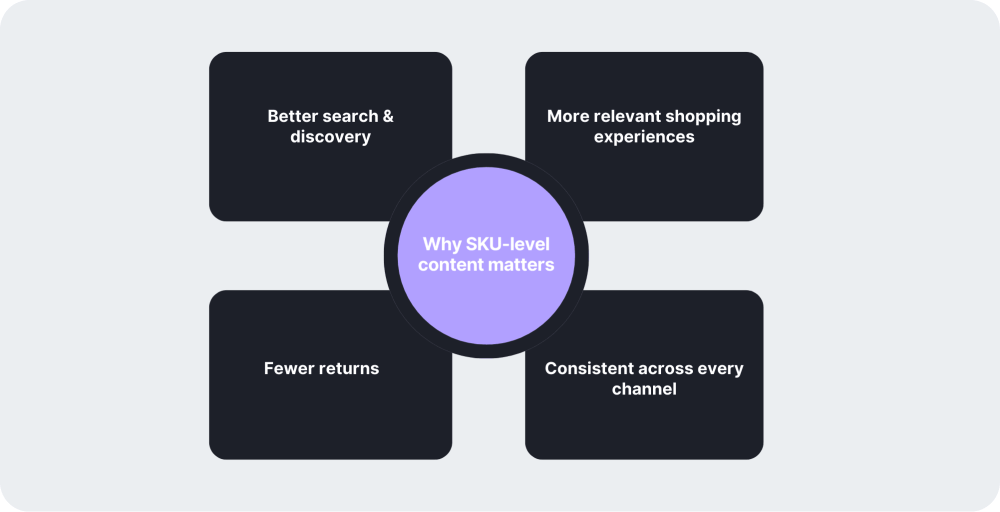Retail content management has never been more complicated—more products, more channels, more ways for customers to discover and buy. And yet, most still rely on broad categories—spring collection, winter coats, or bestsellers. It makes sense on paper, but here’s the problem: your customers don’t shop for “outerwear.” They shop for that puffer jacket in black, in their size, and available now.
So why is so much retail content still built around collections instead of individual products?
Think about it. The way people browse, compare, and buy has completely changed. They’re searching for specifics—exact colours, materials, or even “that one dress Taylor Swift wore last week.” When retailers focus on categories instead of SKUs, customers are forced to dig through generic pages, hoping to find what they’re looking for. And if they can’t? They bounce.
It’s time to stop organising content like a warehouse and start treating it like a personal shopping assistant—one that delivers exactly what customers are searching for, right when they need it.
Let’s break down why this matters and how making the shift can drive better engagement, higher conversions, and a more seamless shopping experience.
Generic content strategies aren’t enough
Most retailers still create content like they’re setting up a department store—broad categories, seasonal collections, and trend-based edits. It seems organised, but it doesn’t match how people actually shop.
When content is built around categories instead of individual products, things start to go wrong:
- Inconsistent product details: One page says “100% organic cotton,” while another says “cotton blend.” Which one is it?
- No personalisation: Customers get recommendations that don’t match their size, colour preference, or past purchases.
- Frustrating search experiences: Ever tried finding an exact product on a retailer’s site, only to give up and check somewhere else? That’s what shoppers do, too.
When missing SKU-level content costs you sales
Here’s what happens when product-level content isn’t up to par:
- A customer orders a jacket listed as “true to size” but gets something two sizes too small—return filed.
- Someone searches for a specific sneaker model, but because the product page lacks detailed specs, they hesitate and leave—sale lost.
- An influencer links to a bestseller, but the product description hasn’t been updated, and now people are unsure if it’s the same item—opportunity missed.
Small gaps in product details lead to bigger problems—confused customers, higher return rates, and lost revenue. Retailers who get this right sell more and make shopping easier, more reliable, and more intuitive.
Why SKU-level content matters
Shoppers don’t browse the way retailers organise their inventory. They search for specific products, compare details, and expect accurate information. SKU-level content makes that possible.

1. Better search & discovery
When every product has the right metadata—like size, material, and colour—it’s easier to find. Whether customers are searching on Google, marketplaces, or your site, SKU-level content helps products show up in the right place at the right time.
2. More relevant shopping experiences
Generic descriptions don’t cut it anymore. Customers want to see the exact product they’re interested in, with the right images, videos, and reviews. SKU-level content ensures they’re looking at the right details, not just a broad category page with dozens of options.
3. Fewer returns
A missing size chart, a colour that looks different in person, or a product description that leaves out key details—these are the reasons returns happen. When product pages include clear, accurate information at the SKU level, customers know exactly what they’re getting before they buy.
4. Consistent across every channel
A product should look the same whether someone sees it on your website, in a marketplace, or in-store display. When SKU-level content is structured properly, customers get a consistent experience wherever they shop.
Retailers who manage content at the SKU level aren’t just making life easier for customers—they’re making sure every product has the best chance to sell, without confusion or unnecessary returns.
How retailers can optimise content at the SKU Level
If customers are searching for specific products, your content should meet them there. Optimising at the SKU level isn’t just about filling out product pages—it’s about making sure every detail is accurate, accessible, and useful. Here’s how to do it.
1. Get the basics right
Each product should have complete, clear, and up-to-date information. Which means:
- Precise product titles (not just “black dress” but “Satin Midi Dress with Adjustable Straps”)
- Detailed descriptions that highlight key features
- High-quality images and videos that show the product from all angles
- Accurate size charts and materials breakdowns
Small details make a big difference when someone is deciding to buy.
2. Make it search-friendly
If your product pages don’t include relevant keywords, they won’t show up when customers search. Use descriptive, natural language that reflects how people actually look for products—think “waterproof running shoes for winter” instead of just “running shoes.”
3. Keep it consistent everywhere
A product shouldn’t look different depending on where someone finds it. The same images, specs, and descriptions should appear across your website, marketplaces, and even in-store digital displays. This prevents confusion and builds trust.
4. Use customer insights to improve content
Look at reviews and customer questions. Are people asking about fit, fabric, or durability? If so, those details should be included in your content. Anticipating customer concerns means fewer abandoned carts and returns.
5. Streamline where you can
Managing SKU-level content manually isn’t realistic at scale. Using a content management system that centralises product data ensures updates happen in real-time across every platform. No more outdated descriptions or missing product specs.
Unlock faster, smarter retail content with Lets Flo
Managing content at the SKU level can feel overwhelming—especially when you’re dealing with thousands of products across multiple channels. That’s exactly where Lets Flo makes a difference.
- Centralise and enrich product content: Lets Flo’s DAM organises and enhances metadata, product descriptions, and styling details, ensuring every SKU has the right information in one place.
- Enhanced copywriting: Lets Flo integrates AI-driven copywriting, speeding up content creation while maintaining accuracy and consistency.
- Ensure consistency across channels: No more scattered or outdated product details. Lets Flo makes it easy to keep content aligned across e-commerce sites, marketplaces, and internal teams.
- Improve content workflow efficiency: Automate content approvals, manage assets efficiently and eliminate the manual back-and-forth that slows down production.
With Lets Flo, retailers manage SKU-level content while optimising it for speed, accuracy, and scalability.
Ready to see Lets Flo in action?
Schedule Demo





